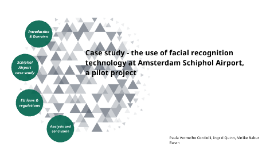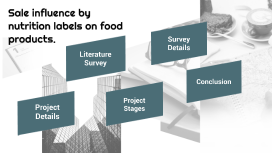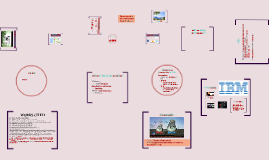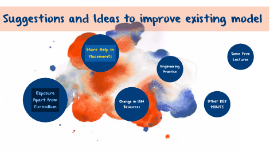BIG DATA PRESENTATION
Transcript: Sale influence by nutrition labels on food products. Project Overview Project Details Nutrition information on food labels have been a buzz among many health conscious individuals now a days. People are becoming aware of the macros associated with each of the food items and the sales of these items are influenced henceforth. In our project, we will be analyzing several of these features collected from our survey and try to find out which of them influences the sale of these entities the most. Sahil Garg -20BDS0174 Ishan Tiwari - 19BDS0071 Aryan Kothari - 19BDS0063 Vaddi Pavan - 19BDS0045 TEAM MEMBERS WHAT ARE WE DOING? INTRO We aim to run a thorough and complete Exploratory Data Analysis on our collected data set and try to find out what are the factors that contribute to the sale affinity of a particular food item. In doing so, we will also list out the undesirable properties of the food items and what is it that repels customers. LITERATURE SURVEY Literature Survey Following is the summary of the research papers and articles we studied Title : Do consumers value nutritional labels? Data suggests that the trade war has slashed the global smartphone market by almost 5% in 2019 alone. The lack of meaningful innovation is one reason sales numbers and smartphone company market share have recently plateaued Title: Nutritional Label and Consumer Buying Decision: A Preliminary Review Globally, by 2021, 40% of the world’s population is predicted to own a smartphone. According to Ericsson, the number of smartphone subscriptions worldwide surpasses six billion and is expected to further grow by several hundred million in the next few years. Authors: Jessie Mandle, Aviva Tugendhaft, Julia Michalow & Karen Hofman Summary: Consumers around the world share preferences with consumers in higher income countries with respect to labelling. However, this may reflect the research study populations, who are often better educated than the general population. Investigation is required into how nutrition labels are received in emerging economies especially among the urban and rural poor, in order to assess the effectiveness of labelling policies. Further research into the outlook of the food and beverage industry, and also on expanded labelling regulations is a priority. Sharing context-specific research regarding labelling between countries in the global South could be mutually beneficial in evaluating obesity prevention policies and strategies. Title: Nutrition labelling: a review of research on consumer and industry response in the global South Innovation and competition in the smartphone industry: Is there a dominant design? Authors: Cliona Ni Mhurchua, Tony Blakely Summary: Over the four-week intervention, study participants (n = 1255) viewed nutrition labels for and/or purchased 66,915 barcoded packaged products. Labels were viewed for 23% of all purchased products, with decreasing frequency over time. Shoppers were most likely to view labels for convenience foods, cereals, snack foods, bread and bakery products, and oils. They were least likely to view labels for sugar and honey products, eggs, fish, fruit and vegetables, and meat. Products for which participants viewed the label and subsequently purchased the product during the same shopping episode were significantly healthier than products where labels were viewed but the product was not subsequently purchased: mean difference in nutrient profile score −0.90 (95% CI -1.54 to −0.26). Title: Do nutrition labels influence healthier food choices? Analysis of label viewing behaviour and subsequent food purchases in a labelling intervention trial Authors: Catherine N. Rasberry, Beth H. Chaney, Jeff M. Housman, Ranjita Misra, and Paula J. Miller Summary: A total of 85.4% of participants claimed to look at nutritional facts labels when purchasing foods “sometimes” (n = 553, 43.0%), “often” (n = 350, 27.2%), or “always” (n = 195, 15.2%). The remaining 14.6% (n = 187) reported they “never” utilize the nutri- tion labels in purchasing decisions. Nine participants did not provide a response to this question. (Missing data was less than 1%.) Title: Determinants of Nutrition Label Use Among College Students Project stages Project Stages Following are the steps we will follow to : STAGES STEPS SURVEY EXPLORATORY DATA ANALYSIS SALE INFLUENCE PREDICTION Strategy Survey Details Our primary focus was on collecting personal preferences of individuals buying food products and from here, we'll try to train our model to predict the buying affinity of an item based off its nutrition labels. FORM CLIPS GOOGLE FORM CLIPS RESPONSES CLIPS CONCLUSION/OUTCOMES Conclusion • Predicting the sale affinity based off the given feature collected from the survey. • Analyzing the influence of various food labels and macro information. • Analyze and predict what are the desirable entities for a food product. • Improve the sale quality by suggesting some changes to a food product which is in demand and also,

















